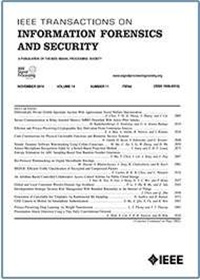流量微元素驱动的流量关系分析:恶意加密流量的鲁棒检测
IF 8
1区 计算机科学
Q1 COMPUTER SCIENCE, THEORY & METHODS
IEEE Transactions on Information Forensics and Security
Pub Date : 2025-09-24
DOI:10.1109/TIFS.2025.3613971
引用次数: 0
摘要
加密技术将网络通信随机化,以保护用户隐私。然而,攻击者利用加密的流量来隐藏恶意活动。现有的检测方法主要依赖于流量内容或交互模式。然而,静态方法很容易被高级攻击所混淆。由于潜在攻击的集合是开放的和无限的,因此模型通常会失去对新攻击的有效性。稳健的加密恶意流量检测仍然是一个有价值的研究领域。本文提出了一种完全基于流量关系的鲁棒无监督加密恶意流量检测模型BSTS-Net。关键动机是构建基于关系的流量上下文表示,并建立异常检测的动态基线。为了表示流中的局部关系,我们创新地引入了流量微元素的概念,它捕获了细粒度的交互模式关系。为了整合交通流之间的全局关系,我们基于Siamese神经网络构建了交通微元素空间。提出了三个优化函数来优化服务内、服务间和节点间的关系。对于鲁棒检测,我们引入了一种声誉增强的动态加密流量检测算法,该算法构建动态基线并持续检测新的异常。我们通过在三个数据集上的大量实验来评估BSTS-Net,并将其与七种SOTA方法进行了比较。我们的结果证明了它的优越性,在多分类场景下,所有数据集的F1得分都超过99.63%。此外,我们模拟了三种对抗情景进行鲁棒性分析。尽管基线方法的F1分数下降了32.21%,但BSTS-Net实现了高性能,仅下降了1%。本文章由计算机程序翻译,如有差异,请以英文原文为准。
Flow Microelement-Driven Traffic Relationship Analysis: Robust Detection of Malicious Encrypted Traffic
Encryption technologies randomize network communication to protect user privacy. However, attackers exploit encrypted traffic to conceal malicious activities. The existing detection methods rely primarily on traffic content or interactive patterns. Nevertheless, static methods can be easily obfuscated by advanced attacks. Since the set of potential attacks is open and infinite, models regularly lose effectiveness against novel attacks. Robust encrypted malicious traffic detection remains a valuable research area. In this paper, we propose BSTS-Net, a robust unsupervised encrypted malicious traffic detection model based entirely on traffic relations. The key motivations are to construct a relation-based traffic contextual representation and to establish dynamic baselines for anomaly detection. To represent local relations within flows, we innovatively introduce the concept of traffic microelements, which capture fine-grained interaction pattern relations. To integrate the global relationships between flows, we construct a traffic microelement space based on the Siamese neural network. Three optimization functions are proposed to optimize the intraservice, interservice and internode relations. For robust detection, we introduce a reputation-enhanced dynamic encrypted traffic detection algorithm that constructs dynamic baselines and continuously detects novel anomalies. We evaluate BSTS-Net through extensive experiments on three datasets and compare it with seven SOTA methods. Our results demonstrate its superiority, with an F1 score of more than 99.63% across all the datasets in multiclassification scenarios. Additionally, we simulate three adversarial scenarios for robustness analysis. Although the baseline methods experience an F1 score degradation of 32.21%, BSTS-Net achieves high performance, with only 1% degradation.
求助全文
通过发布文献求助,成功后即可免费获取论文全文。
去求助
来源期刊

IEEE Transactions on Information Forensics and Security
工程技术-工程:电子与电气
CiteScore
14.40
自引率
7.40%
发文量
234
审稿时长
6.5 months
期刊介绍:
The IEEE Transactions on Information Forensics and Security covers the sciences, technologies, and applications relating to information forensics, information security, biometrics, surveillance and systems applications that incorporate these features
 求助内容:
求助内容: 应助结果提醒方式:
应助结果提醒方式:


